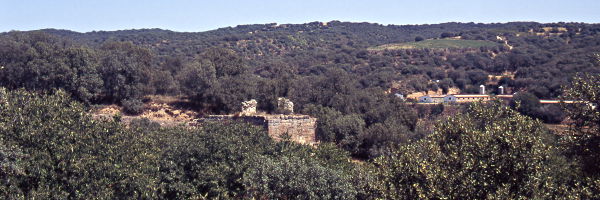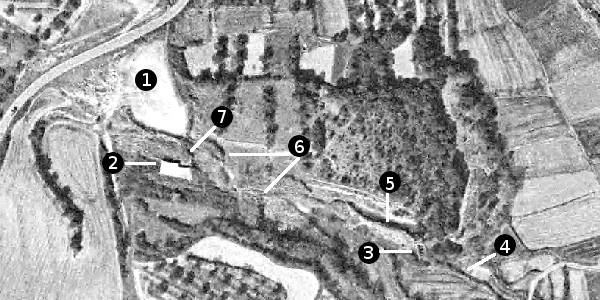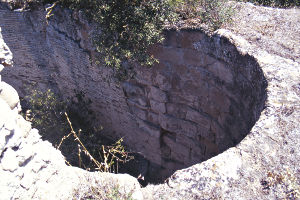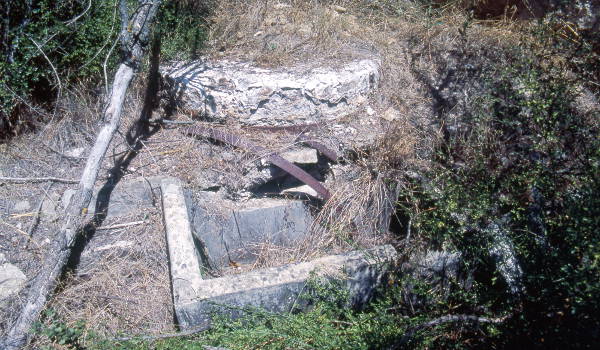Aerial photographs taken in the 1970s by the Instituto Geográfico Nacional
of Spain make it easier to appreciate the configuration of the site (2).
Notice that, in 1978, the roof of the lower mill (2 pt3) was already gone. The only earlier aerograph I could find, dates
from 1956 and at that time both mills had their roof in place.
From the air one can more clearly appreciate how both mills relate to each other.
The system is fed by the Acequia del Molino de Falague which enters the embalse (2 pt1) in its top right corner.
From the pond water could reach the lower mill by two ways (2 pt6). First there is the spillway which drains water
towards a canal at the foot of the hill. This canal received also the outflow of the upper mill and flew out
into the pond (2 pt5, 4) of the mill at hand.
The millpond is narrow and long and ends in
the cubo (3-5) which is built from ashlar stone.
This cubo is entirely different from the upper mill's which is a deep cilinder and therefore
a real cubo like in the mills of f.e.
Lacort,
Centenera, or
Las Bellostas.
What we have here is a cilinder which is open towards the pond.
In some occasions (e.g.
Aguinalíu) only the upper part of the cubo is open to the pond whilst the bottom half is a closed cilinder.
If present, the closed bottom part must be hidden below the silt accumulated in the pond. However, looking at the
the stones, I do not think there is enough depth left for such a closed cubo.
The mill was built along the slope of the plateau (6, 7).
There is enough left of the walls to appreciate the dimensions of the construction.
The mill was long and narrow, too narrow to house more than one couple of stones.
Standing inside the mill and looking toward the pond (7) it becomes clear that the cubo is built
on top of a big rock and that somehow this rock had to be perforated in order to bring water to the wheel.
The stones (7, 8) are composite. The metal straps came loose
and the runner is so heavily eroded that the individual pieces of stone can be seen.
Next to the stones there is a cemented farinal (8). This is where the fresh meal was collected before it was bagged.
In most mills of the region the farinal is made of wood (e.g. Humo de Muro,
Las Almunias de Rodellar and more).
† José Manuel Naval Carceller & Juan Rovira Marsal —1995— Los molinos hidráulicos de la comarca de La Litera (Huesca).
Primeras jornadas nacionales sobre molinología; p387-399.
in Cadernos do seminario de Sargadelos. A Coruña:
Fundación Juanelo Turriano. Seminario de Sargadelos. Museo do Pobo Galego, 1997; 880p.; ISBN: 84-7492-862-1.









